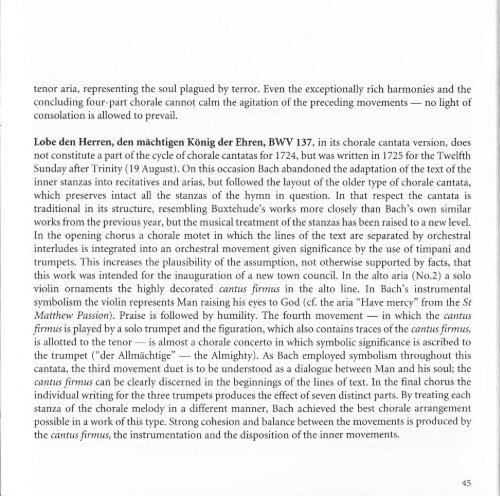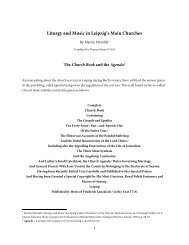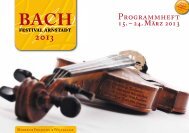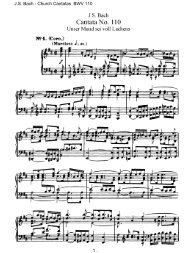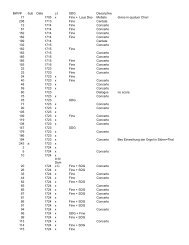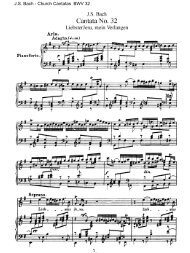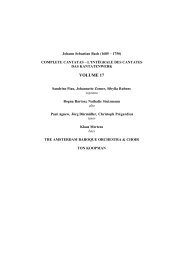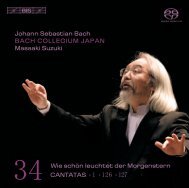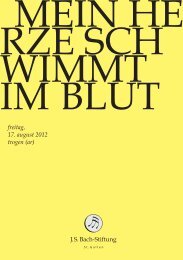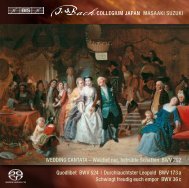Bach Cantatas, Vol. 2 - F. Werner (Erato 10-CD)
Bach Cantatas, Vol. 2 - F. Werner (Erato 10-CD)
Bach Cantatas, Vol. 2 - F. Werner (Erato 10-CD)
You also want an ePaper? Increase the reach of your titles
YUMPU automatically turns print PDFs into web optimized ePapers that Google loves.
tenor aria, representing the soul plagued by terror. Even the exceptionally rich harmonies and the<br />
concluding four-part chorale cannot calm the agitation of the preceding movements<br />
-<br />
no light of<br />
consolation is allowed to prevail.<br />
Lobe den Herren, den mächtigen König der Ehren, BWV 137, in its chorale cantata version, does<br />
not constitute a part of the cycle of chorale cantatas for 1724, but was written in 1725 for the Twelfth<br />
Sunday after Trinity ( 19 August). On this occasion <strong>Bach</strong> abandoned the adaptation of the text of the<br />
inner stanzas into recitatives and arias, but followed the layout of the older qpe of chorale cantata,<br />
which preserves intact all the stanzas of the hymn in question. In that respect the cantata is<br />
traditional in its structure, resembling Buxtehude's works more closely than <strong>Bach</strong>'s own similar<br />
works from the previous year, but the musical treatment of the stanzas has been raised to a new level.<br />
In the opening chorus a chorale motet in which the lines of the text are separated by orchestral<br />
interludes is integrated into an orchestral movement given significance by the use of timpani and<br />
trumpets. This increases the plausibility of the assumption, not otherwise supported by facts, that<br />
this work was intended for the inauguration of a new town council. In the alto aria (No.2) a solo<br />
violin ornaments the highly decorated cantus firmus in the alto line. In <strong>Bach</strong>'s instrumental<br />
syrnbolism the violin represents Man raising his eyes to God (cf. the aria "Have mercy" from the Sr<br />
Matthew Passion). Praise is followed by humility. The fourth movement -<br />
in which the cantus<br />
firmus is played by a solo trumpet and the figuration, which also contains traces of the cantus firmus,<br />
is allotted to the tenor is almost a chorale concerto in which symbolic significance is ascribed to<br />
the trumpet ("der Allmächtige" -<br />
the Almighty). As <strong>Bach</strong> employed symbolism throughout this<br />
cantata, the third movement duet -<br />
is to be understood as a dialogue between Man and his soul; the<br />
cantus firmus can be clearly discerned in the beginnings of the lines of text. In the final chorus the<br />
individual writing for the three trumpets produces the effect of seven distinct parts. By treating each<br />
stanza of the chorale melody in a different manner, <strong>Bach</strong> achieved the best chorale arrangement<br />
possible in a work of this type. Strong cohesion and balance between the movements is produced by<br />
the cantus firmus,the instrumentation and the disposition of the inner movements.


